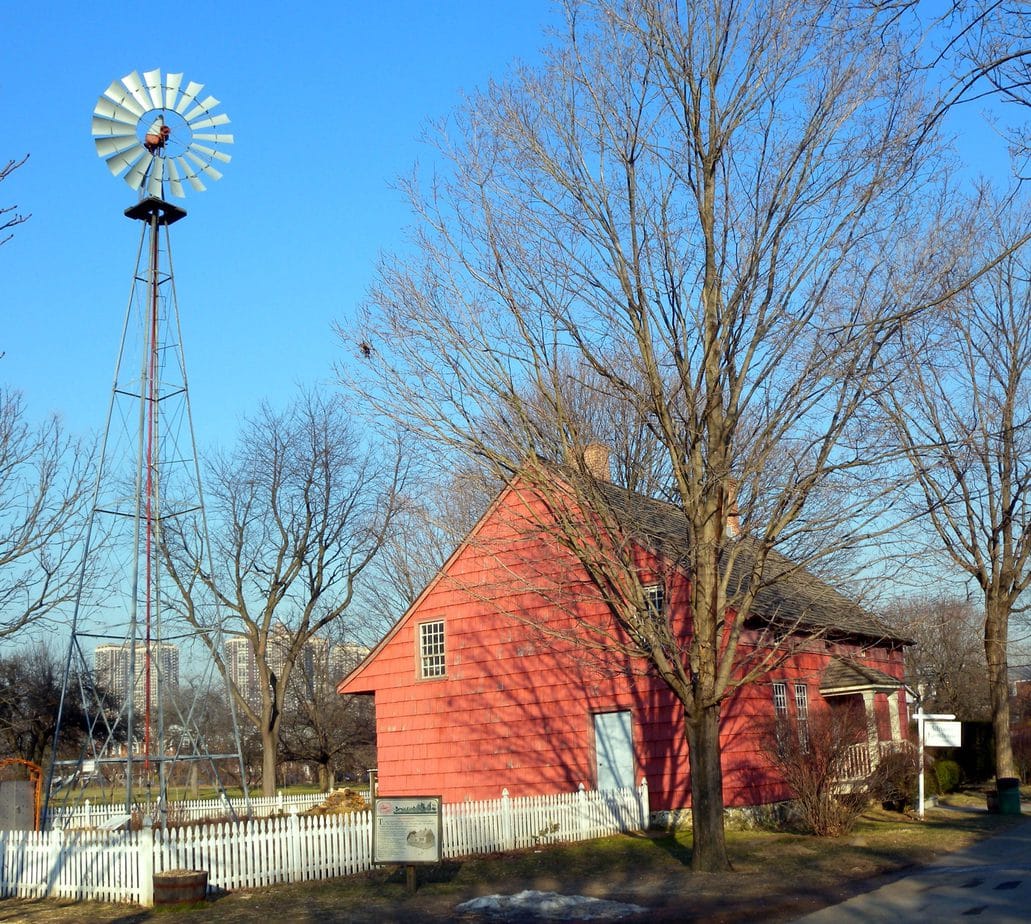New York is one the original 13 American colonies and was one of the first areas that Europeans settled. Due to this, some of the oldest buildings in the United States are found in New York City and all of its boroughs (Queens, Manhattan, Brooklyn, The Bronx, and Staten Island). Most of the old buildings on this list started out as private homes and have since been turned into museums.
10. Queens County Farm Museum
Year Built: 1697
Location: 73-50 Little Neck Pkwy, Queens
Original Purpose: Farm
Current Purpose: Museum and Working Farm

The Queens County Farm Museum dates back to 1697 and is surprisingly still a working farm, making it the oldest farm in New York and one of the oldest in the country. The farm sits on the largest remaining tract of undisturbed farmland in New York and covers 47 acres. The Queens County Farm Museum has had several owners over the years, beginning with Jacob and Catherine Adriance. The farm and all of its properties became a New York City landmark in 1975 and was added to the National Register of Historic Places.
Did You Know?
The Queens County Farm Museum receives more than 400,000 visitors each year.
9. Old Quaker Meeting House
Year Built: 1694
Location: 137-16 Northern Boulevard, Flushing, Queens
Original Purpose: Quaker House of Worship
Current Purpose: Quaker House of Worship

The Old Quaker Meeting House is one of the only buildings on this list still being used for its original purpose. As its name suggests, the Old Quaker Meeting House is a house of worship for Quakers. The meeting house was first built in 1694 by John Bowne and other early Quakers in the area. Although, the building is in need of repair, the Old Quaker Meeting House still hosts meetings and Sunday School.
Did You Know?
The Old Quaker Meeting House is the oldest house of worship in New York and the second oldest Quaker meeting house in the United States.
8. Alice Austen House
Year Built: 1690
Location: 2 Hylan Boulevard, Rosebank, Staten Island
Original Purpose: Private Residence
Current Purpose: Museum

The Alice Austen House remained in the ownership of the Austen family until 1945, when Alice could no longer afford the upkeep. Since the 1970s, the Alice Austen House has been owned by New York City and open to the public as a museum.
Did You Know?
Reportedly, the Alice Austen House is haunted by ghosts of slaves who were kept there during the American Revolution.
7. The Conference House
Year Built: c.1680
Location: Conference House Park, Tottenville, Staten Island
Original Purpose: Private Residence
Current Purpose: Museum

Although all of the buildings have some historical significance, the Conference House in Staten Island was the site of a famous unsuccessful peace conference that took place during the American Revolution. In 1776, Continental Congress representatives John Adams, Edward Rutledge, and Benjamin Franklin met with the King’s representative, Lord Richard Howe, at Colonel Christopher Billopp’s home (the Conference House) to negotiate the terms of independence – no reconciliation was reached.
The Conference House was built around 1680 by Captain Christopher Billopp. Since 1926, the Conference House and the surrounding land have been a park, recreational area, and museum.
Did You Know?
The Conference House became the first house museum on Staten Island in 1926.
6. Jans Martense Schenck House
Year Built: c.1675
Location: Inside of the Brooklyn Museum
Original Purpose: Private Residence
Current Purpose: Long-term Museum Installation

The Jans Martense Schenck House is perhaps the most interesting building on this list because it is a museum installation inside of the Brooklyn Museum! The house was built around 1675 by Jans Martense Schenck, a Dutch immigrant who arrived in New Netherland in 1650, in the town of Flatlands.
For over 275 years, the Jans Martense Schenck House stood in its original location in Flatlands before it was moved into the Brooklyn Museum in 2006. Although the house has undergone several changes, the Brooklyn Museum chose to capture early Dutch colonial life during the early 18th century.
Did You Know?
The Jans Martense Schenck House was painted gray for many years, but analysis of the exterior paint layers of the original clapboard show that the house was initially white and later red. The Brooklyn Museum chose to paint the house red because it believes the house would have been painted red within the first few decades of the 18th century.
5. The Britton Cottage
Year Built: c.1670
Location: Richmond Road, Richmondtown, Staten Island
Original Purpose: Private Residence (possibly also a public building)
Current Purpose: NYC Landmark not currently open to the public

The Britton Cottage, formerly the Cubberly House, is another historic building in Richmondtown on Staten Island. The oldest part of the house, the center section, was built sometime around 1670 and two additions were added in 1760. A lean-to was built before 1840.
Although there are no records of when exactly the Britton Cottage was first built, the land that the house originally rested on was officially granted to Obadiah Holmes in 1677. The house went to the Britton family in 1695 and it was owned by several different families after. Currently, the Britton Cottage is owned by the Staten Island Historical Society and is awaiting restoration and not open to the public at this time.
Did You Know?
The Britton Cottage was moved from its original location at the foot of present-day New Dorp Lane, near Cedar Grove Avenue, in New Dorp Beach to Historic Richmond Town in 1965.
4. Billiou-Stillwell-Perine House
Year Built: c.1662 to 1663
Location: 1476 Richmond Road, Staten Island
Original Purpose: Private Residence
Current Purpose: NYC Landmark occasionally open to the public

Like nearly all of the old buildings on this list the Billiou-Stillwell-Perine House was originally built as a private residence and now serves as a museum/historical landmark showcasing the lives of early European settlers in New York. The Billiou-Stillwell-Perine House was built around 1662 or 1663 Pierre Billiou, a Huguenot (French Protestants) who arrived at New Amsterdam fleeing religious persecution in Europe in 1661.
Billiou’s descendants, the Stillwells and the Brittons lived in the house until the mid-18th century. The house was then acquired by the Perine Family in 1758, who passed the house down until 1913. Today, the Billiou-Stillwell-Perine House is owned and operated by Historic Richmond Town.
Did You Know?
During the American Revolution, when Ann Perine lived in the Billiou-Stillwell-Perine House with her seven children, British troops occupied the property and damaged it by cutting down a large number of trees.
3. The Bowne House
Year Built: c.1661
Location: 37-01 Bowne St., Flushing, Queens
Original Purpose: Private Residence and Quaker Meeting House
Current Purpose: Museum

Although, the Lent-Riker-Smith Homestead is about a decade older, the Bowne House proudly claims that it is the oldest house/building in Queens. The house was originally built around 1661 by John Bowne, who immigrated from England in 1649. The Bownes and later the Parsons, who married into the Bowne family, owned the Bowne homestead until 1945. That year the family donated the Bowne House to Bowne Historical Society and it has operated as museum since 1947. The Bowne House was added to the U.S. National Register of Historic Places in 1977.
Did You Know?
In 1662, a Quaker meeting was held in the Bowne House, which resulted in the arrest of John Bowne y Peter Stuyvesant, Dutch Director-General of New Netherland. Bowne successfully appealed the arrest and his appeal helped to serve as the basis for the later guarantees of freedom of religion, speech and right of assembly in the American Constitution.
2. Lent-Riker-Smith Homestead
Year Built: c.1654 to 1656
Location: 78-03 19th Road, East Elmhurst, Queens
Original Purpose: Private Homestead
Current Purpose: Private Residence that is open to the public through private tours

The Lent-Riker-Smith Homestead dates back to around 1654 and was built as a one room dwelling by Abraham Riker – whose last name is familiar because he was part of the Riker family for whom Rikers Island was named for. The house remained in the Riker and Lent (descendants of the Rikers) family for several generations and has been expanded and renovated numerous times.
The current owner of the Lent-Riker-Smith Homestead is Marion Duckworth Smith who took over running the house after her husband Michael Smith passed. Michael Smith was a tenant of the house in the 1960s and went on to purchase the property in 1975. The Smiths have completely restored the property and private tours can be arranged.
Did You Know?
In addition to the house, the Lent-Riker-Smith Homestead also contains the Riker family graveyard, which has over 132 marked graves of the Rikers and Lents.
1. Wyckoff House
Year Built: 1652
Location: 5816 Claredon Road, Canarsie, Brooklyn
Original Purpose: Private Homestead
Current Purpose: Museum

The reason why the Wyckoff House has the name Wyckoff instead of Claesen is because Pieter chose the surname Wykhof after being required to choose a last name to pass down to his descendants. It is believed that Pieter picked Wykhof in recognition of a farm by the same name outside of Marienhafe, Germany where his family were likely tenants.
Did You Know?
The last name Wyckoff is so unique that the vast majority of American and Canadian Wyckoffs can trace their lineage to one of Pieter and Grietje’s eleven children.











